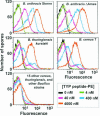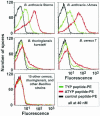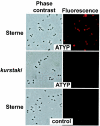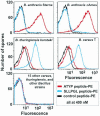Species-specific peptide ligands for the detection of Bacillus anthracis spores
- PMID: 14532093
- PMCID: PMC201196
- DOI: 10.1128/AEM.69.10.6288-6293.2003
Species-specific peptide ligands for the detection of Bacillus anthracis spores
Abstract
Currently available detectors for spores of Bacillus anthracis, the causative agent of anthrax, are inadequate for frontline use and general monitoring. There is a critical need for simple, rugged, and inexpensive detectors capable of accurate and direct identification of B. anthracis spores. Necessary components in such detectors are stable ligands that bind tightly and specifically to target spores. By screening a phage display peptide library, we identified a family of peptides, with the consensus sequence TYPXPXR, that bind selectively to B. anthracis spores. We extended this work by identifying a peptide variant, ATYPLPIR, with enhanced ability to bind to B. anthracis spores and an additional peptide, SLLPGLP, that preferentially binds to spores of species phylogenetically similar to, but distinct from, B. anthracis. These two peptides were used in tandem in simple assays to rapidly and unambiguously identify B. anthracis spores. We envision that these peptides can be used as sensors in economical and portable B. anthracis spore detectors that are essentially free of false-positive signals due to other environmental Bacillus spores.
Figures




Similar articles
-
Discovery of phage display peptide ligands for species-specific detection of Bacillus spores.J Microbiol Methods. 2003 May;53(2):263-71. doi: 10.1016/s0167-7012(03)00030-7. J Microbiol Methods. 2003. PMID: 12654497 Review.
-
Identification and validation of specific markers of Bacillus anthracis spores by proteomics and genomics approaches.Mol Cell Proteomics. 2014 Mar;13(3):716-32. doi: 10.1074/mcp.M113.032946. Epub 2013 Dec 29. Mol Cell Proteomics. 2014. PMID: 24379445 Free PMC article.
-
Selective detection of 1000 B. anthracis spores within 15 minutes using a peptide functionalized SERS assay.Analyst. 2014 Dec 21;139(24):6366-70. doi: 10.1039/c4an01163e. Analyst. 2014. PMID: 25263740
-
Peptide ligands that bind selectively to spores of Bacillus subtilis and closely related species.Appl Environ Microbiol. 2003 Nov;69(11):6841-7. doi: 10.1128/AEM.69.11.6841-6847.2003. Appl Environ Microbiol. 2003. PMID: 14602648 Free PMC article.
-
Spores and soil from six sides: interdisciplinarity and the environmental biology of anthrax (Bacillus anthracis).Biol Rev Camb Philos Soc. 2018 Nov;93(4):1813-1831. doi: 10.1111/brv.12420. Epub 2018 May 6. Biol Rev Camb Philos Soc. 2018. PMID: 29732670 Review.
Cited by
-
Morphogenesis of the Bacillus anthracis spore.J Bacteriol. 2007 Feb;189(3):691-705. doi: 10.1128/JB.00921-06. Epub 2006 Nov 17. J Bacteriol. 2007. PMID: 17114257 Free PMC article.
-
Determination of the glycation sites of Bacillus anthracis neoglycoconjugate vaccine by MALDI-TOF/TOF-CID-MS/MS and LC-ESI-QqTOF-tandem mass spectrometry.J Mass Spectrom. 2011 Oct;46(10):993-1003. doi: 10.1002/jms.1980. J Mass Spectrom. 2011. PMID: 22012665 Free PMC article.
-
Proximity ligation assays with peptide conjugate 'burrs' for the sensitive detection of spores.Nucleic Acids Res. 2005 Oct 19;33(18):e162. doi: 10.1093/nar/gni150. Nucleic Acids Res. 2005. PMID: 16237122 Free PMC article.
-
The ExsY protein is required for complete formation of the exosporium of Bacillus anthracis.J Bacteriol. 2006 Nov;188(21):7440-8. doi: 10.1128/JB.00639-06. Epub 2006 Aug 25. J Bacteriol. 2006. PMID: 16936017 Free PMC article.
-
Detection of B. anthracis spores and vegetative cells with the same monoclonal antibodies.PLoS One. 2009 Nov 13;4(11):e7810. doi: 10.1371/journal.pone.0007810. PLoS One. 2009. PMID: 19915677 Free PMC article.
References
-
- Ash, C., J. A. E. Farrow, S. Wallbanks, and M. D. Collins. 1991. Phylogenetic heterogeneity of the genus Bacillus revealed by comparative analysis of small-subunit-ribosomal RNA sequences. Lett. Appl. Microbiol. 13:202-206.
-
- Chan, W. C., D. J. Maxwell, X. Gao, R. E. Bailey, M. Han, and S. Nie. 2002. Luminescent quantum dots for multiplexed biological detection and imaging. Curr. Opin. Biotechnol. 13:40-46. - PubMed
-
- Gerhardt, P. 1967. Cytology of Bacillus anthracis. Fed. Proc. 26:1504-1517. - PubMed
Publication types
MeSH terms
Substances
LinkOut - more resources
Full Text Sources
Other Literature Sources

